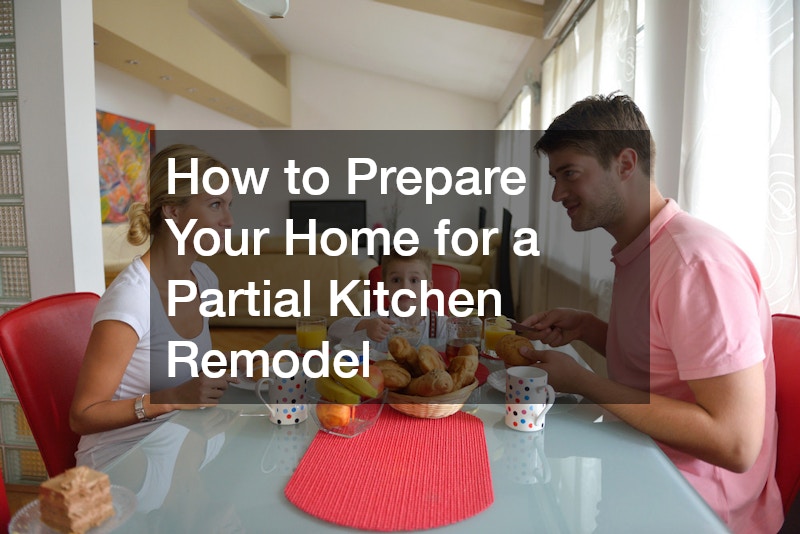
When it comes to home improvement projects, a partial kitchen remodel can make a big impact without breaking the bank. Whether you want to update the look of your kitchen or increase its functionality, planning is key to a successful remodel. In this comprehensive guide, we will walk you through the essential steps to take when undertaking a kitchen remodel.
Define Your Goals and Budget

Before diving into any remodeling project, it is essential to define your goals and set a realistic budget. Consider what aspects of your kitchen you want to improve, whether it’s the layout, appliances, or overall aesthetics. Determine how much you are willing to invest in the project to ensure that your vision aligns with your financial constraints.
Research different kitchen remodeling companies and services to get an idea of the costs associated with a partial kitchen remodel. Compare quotes from multiple contractors to find the best fit for your budget and needs. Remember that quality work often comes at a higher price, so prioritize your goals accordingly.
By establishing clear goals and a budget upfront with kitchen remodeling services, you can streamline the remodeling process and avoid unexpected costs down the line. Communicate your expectations with your chosen contractor to ensure that your vision for the kitchen remodel is achievable within your financial means.
Research and Gather Inspiration
Before starting your partial kitchen remodel, gather inspiration from various sources to help you envision the final outcome. Browse design magazines, websites, and social media platforms for ideas on layout, color schemes, and materials. Create a mood board or Pinterest board to compile your favorite design elements and share them with your contractor.
Consult with a kitchen remodeling company to discuss your ideas and gather feedback on what is feasible within your space and budget. Ask for samples of materials and finishes to help you make informed decisions about your kitchen remodel. Be open to suggestions from professionals to enhance the functionality and aesthetic appeal of your space.
Visiting showrooms and attending home remodeling expos can also provide valuable insights into the latest trends and technologies in kitchen design. Take note of innovative features and products that could elevate your kitchen remodel and enhance your overall cooking experience.
Choose Your Remodeling Style
When planning a kitchen remodel, it’s essential to choose a remodeling style that suits your personal taste and complements the existing design of your home. Whether you prefer a modern, traditional, or eclectic look, select elements that reflect your lifestyle and personality. Coordinate with your contractor to ensure that your chosen style is cohesive and harmonious with the rest of your home.
Consider the layout of your kitchen and how it can be optimized to enhance functionality and flow. Explore different cabinetry options, countertop materials, and lighting fixtures to achieve the desired aesthetic. Customize your remodel with unique features such as a kitchen island, pantry storage, or built-in appliances to make the space truly your own.
Avoid trends that may quickly become outdated and opt for timeless design choices that will stand the test of time. Consult with a remodeling company or design experts to help you create a cohesive and visually appealing aesthetic that aligns with your personal preferences and lifestyle needs.
Create a Timeline

Once you have defined your goals, budget, and style for your partial kitchen remodel, it’s time to create a realistic timeline for the project. Discuss the scope of work with your contractor and establish a timeline that accommodates any potential delays or unforeseen challenges. Be prepared to be flexible and patient throughout the remodeling process.
Consider factors such as lead times for materials, appliance deliveries, and contractor availability when mapping out your timeline. Communicate with your custom remodeling service regularly to track progress and address any issues that may arise during the remodel. Set milestones and deadlines to keep the project on track and ensure that the work is completed in a timely manner.
A well-planned timeline can help you manage expectations and minimize disruptions to your daily routine. Anticipate any temporary inconveniences, such as restricted access to the kitchen, and plan accordingly to maintain a sense of normalcy during the remodel.
Plan for Temporary Cooking Solutions
During a partial kitchen remodel, it’s essential to plan for temporary cooking solutions to avoid interruptions to your daily meals. Set up a makeshift kitchen in another area of your home with essential appliances such as a microwave, toaster oven, and electric kettle. Stock up on non-perishable foods and disposable dinnerware to simplify meal preparation and cleanup.
Coordinate with your remodeling contractors to determine the best location for your temporary kitchen and ensure access to water and electricity for basic cooking needs. Communicate your cooking preferences and dietary restrictions to minimize disruptions and make meal planning easier during the remodel. Consider scheduling takeout or dining out on occasion to give yourself a break from cooking at home.
Stay organized and maintain a positive attitude throughout the remodeling process to reduce stress and make the most of the temporary cooking situation. Keep essential kitchen utensils and tools within reach to streamline meal preparation and maintain a sense of normalcy during the kitchen remodel.
Clear Out the Kitchen Space
Prior to the start of your partial kitchen remodel, clear out the existing space to create a clean and clutter-free environment for the contractors. Remove all items from cabinets, drawers, and countertops to allow for easy access and prevent damage during the renovation. Pack away fragile or valuable items to protect them from dust and debris.
Donate or discard any items that you no longer need or use to streamline the decluttering process. Store essential kitchen essentials in boxes or bins that can be easily accessed during the remodel. Create a designated storage area for appliances, cookware, and pantry items to keep your essentials organized and accessible throughout the kitchen remodel.
Clean the empty space thoroughly before the home remodeling companies begin work to ensure a dust-free environment and facilitate the installation of new fixtures and materials. Take this opportunity to purge unused or expired items from your kitchen and create a fresh start for your remodel. Maintain a tidy space throughout the renovation to promote a sense of calm and order during the chaos of construction.
Communicate With Contractors

Effective communication with your contractor is crucial to the success of your partial kitchen remodel. Establish clear expectations, timelines, and budget constraints at the outset to avoid misunderstandings or delays. Regularly check in with your contractor to discuss progress, address any concerns, and make decisions about design choices and materials.
Be proactive in communicating any changes or modifications to the original plan to ensure that the project stays on track and aligns with your vision. Ask for regular updates on the status of the remodel and address any issues promptly to avoid disruptions to the schedule. Collaborate with your contractor to find creative solutions to challenges that may arise during the renovation.
Establish a rapport with your remodeling services based on trust and open communication to foster a positive working relationship. Keep lines of communication open and address any issues or concerns promptly to maintain a sense of transparency and accountability throughout the kitchen remodel. By working together as a team, you can ensure a successful and satisfying outcome for your project.
Consider Temporary Living Arrangements
Depending on the extent of your partial kitchen remodel, you may need to consider temporary living arrangements to accommodate the construction process. If your kitchen is the heart of your home, plan ahead for alternative cooking and dining spaces to minimize disruptions to your daily routine. Set up a temporary kitchenette in a different area of your home with essential appliances and supplies to maintain some level of normalcy.
Explore options for short-term rentals or extended stays with family or friends if the renovation is extensive and will impact your ability to cook and eat at home. Consider the needs of your family members, including children and pets, and make arrangements to ensure their comfort and safety during the remodel. Communicate with your contractor about your living arrangements to coordinate access and minimize disturbances during the construction phase.
Prioritize your well-being and comfort during the kitchen remodel by planning for alternative living arrangements that suit your needs and lifestyle. Stay flexible and open-minded to different solutions that will allow you to navigate the renovation process with ease and minimal stress. With careful planning and foresight with kitchen remodelers, you can make the most of temporary living arrangements and maintain a sense of normalcy during the remodel.
Protect Surrounding Areas
When undergoing a kitchen remodel, it’s important to protect the surrounding areas of your home to prevent damage and maintain a clean and safe work environment. Use barriers such as plastic sheeting or tarps to contain dust and debris generated during the renovation. Cover floors, furniture, and fixtures with protective materials to shield them from construction-related wear and tear.
Ensure that proper ventilation is in place to minimize dust and fumes from spreading to other areas of your home during the remodel. Communicate with your contractor about protective measures that will be taken to safeguard your property and belongings throughout the renovation. Implement a daily cleanup routine to maintain a tidy work area and prevent accidents or injuries during the partial kitchen remodel.
Be proactive in addressing any concerns about the protection of your home and communicate with your full house remodeling contractor about any potential risks or hazards that may arise during the renovation. Prioritize the safety and well-being of your family and pets by taking precautions to minimize disruptions and mitigate any potential damage to your property. By protecting surrounding areas, you can ensure a smooth and successful kitchen remodel that enhances the beauty and functionality of your space.
Update Utilities as Needed
As part of your partial kitchen remodel, it may be necessary to update or upgrade utilities such as plumbing, electrical, and HVAC systems to ensure they meet current building codes and safety standards. Consult with your contractor to assess the condition of existing utilities and determine if any modifications or replacements are needed. Plan ahead for any necessary upgrades to avoid delays or additional costs during the renovation.
Coordinate with licensed professionals to inspect and update utilities as needed, including installing new plumbing fixtures, upgrading electrical outlets, and improving ventilation in your kitchen. Factor the costs of utility upgrades into your budget to ensure that your remodel is compliant with local regulations and industry standards. Prioritize the safety and functionality of your utilities to create a more efficient and comfortable kitchen space.
By updating utilities as needed, you can enhance the performance and longevity of your kitchen remodel and create a safer and more energy-efficient environment for cooking and dining. Invest in quality materials and workmanship to ensure that your utilities are up to code and aligned with the latest industry standards. Collaborate with professionals to design a kitchen space that is both beautiful and functional for years to come.
Budget for Unexpected Costs

During a partial kitchen remodel, it’s essential to budget for unexpected costs that may arise during the renovation process. Set aside a contingency fund of 10-20% of your total budget to cover unforeseen expenses such as structural repairs, permit fees, or design changes. Anticipate potential challenges and plan for contingencies to avoid budget overruns and delays.
Consult with your contractor to identify potential risks and challenges that may impact the cost of your remodel and develop a plan to address them proactively. Prioritize essential upgrades and repairs to ensure that your kitchen remodel remains within budget and on schedule. Be prepared to make trade-offs and adjustments to your original plan to accommodate unexpected costs without compromising the quality of your remodel.
By budgeting for unexpected costs, you can safeguard your investment and ensure a successful outcome for your kitchen remodel. Stay flexible and adaptable to changes in scope or budget to navigate unforeseen challenges with confidence and ease. Work closely with your contractor to monitor costs and make informed decisions that align with your financial goals and priorities.
A partial kitchen remodel is a significant undertaking that requires careful planning, communication, and collaboration with skilled professionals. By defining your goals, budget, and style upfront, you can create a roadmap for a successful remodel that meets your needs and exceeds your expectations. Researching and gathering inspiration, creating a timeline, and communicating effectively with your contractor are essential steps to ensure a smooth and stress-free remodeling process.
